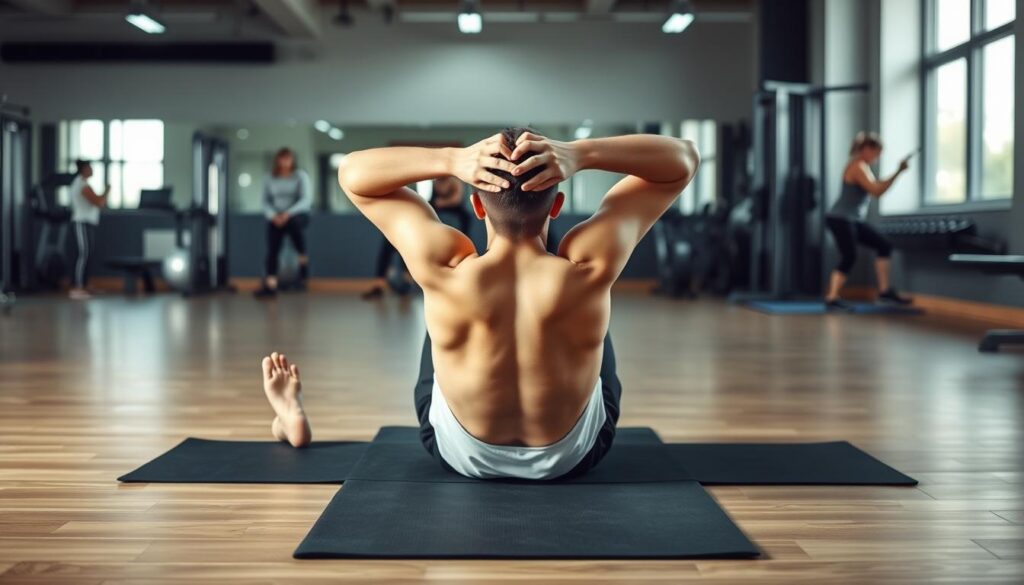Are you ready for the tough physical demands of military service? The sit-up test is a big part of the Physical Fitness Test.
The military fitness requirements make sure everyone can do their job well. To pass boot camp and move on to Advanced Infantry Training, you must do well in the Basic Training APFT. This includes the sit-up test.
The sit-up test checks your core strength and how long you can keep going. Knowing the Army sit-up standards helps you get ready for what’s coming.
Key Takeaways
- The sit-up test is a key part of the Army’s Physical Fitness Test.
- Passing the APFT is needed to finish boot camp.
- The sit-up score looks at your core strength and how long you can keep going.
- Knowing the standards helps you get ready for the challenges ahead.
- The Physical Fitness Test checks your overall fitness.
Importance of Sit-Ups in Army Fitness Assessments
Sit-ups are key in the Army Physical Fitness Test. They check a soldier’s core strength and endurance. The Army Physical Fitness Test (APFT) is a test that shows if a soldier is ready to do their job well.
Overview of Army Physical Fitness Test (APFT)
The APFT tests a soldier’s fitness with three exercises: push-ups, sit-ups, and a 2-mile run. It scores how many push-ups and sit-ups a soldier can do in a time. The 2-mile run is timed too. Sit-ups focus on the abdominal muscles, showing a soldier’s core strength.
The APFT has different standards for each age and gender. This makes sure soldiers are judged fairly. For example, how many sit-ups a soldier needs to pass changes with age and gender.

Role of Core Strength in Soldier Performance
Core strength is very important for soldiers. It helps them do tough tasks better. A strong core means better stability and balance, which lowers injury risk.
The sit-up test in the APFT is key for measuring core strength. Soldiers with strong cores do better in tasks like carrying heavy loads or going through tough terrain.
| Age Group | Male Minimum Sit-Ups | Female Minimum Sit-Ups |
|---|---|---|
| 17-21 | 38 | 19 |
| 22-26 | 38 | 19 |
| 27-31 | 35 | 19 |
Working on core strength with sit-ups helps soldiers perform better. It makes them more ready for military tasks.
Army Sit-Up Standards and Requirements
Army sit-up standards change with age and gender. It’s key for soldiers to know these fitness test requirements to prepare well.
The Army Physical Fitness Test (APFT) checks a soldier’s fitness in three areas: push-ups, sit-ups, and a 2-mile run. Sit-ups test core strength and endurance.
Minimum Repetitions for Each Age Group
The APFT has different sit-up requirements for each age group. Army FM 7-22 and Department of the Army Form 705 outline these minimums:
- For soldiers aged 17-21, the minimum is 40 sit-ups for males and 30 for females.
- For soldiers aged 22-26, the minimum is 38 for males and 28 for females.
- For soldiers aged 27-31, the minimum is 36 for males and 26 for females.
- For soldiers aged 32-36, the minimum is 34 for males and 24 for females.
- For soldiers aged 37-41, the minimum is 32 for males and 22 for females.
- For soldiers aged 42-46, the minimum is 30 for males and 20 for females.
- For soldiers aged 47-51, the minimum is 28 for males and 18 for females.
- For soldiers aged 52 and above, the minimum is 26 for males and 16 for females.
Standards for Males vs. Females
The APFT has different standards for males and females. The military sit-up chart shows these differences. This ensures fair testing for both genders.
Scoring System Explained
The APFT scores soldiers based on sit-ups done in 2 minutes. The score shows a soldier’s fitness level. To get the highest score, soldiers must do the most sit-ups for their age and gender.
Knowing the proper sit-up technique is key for a high score. Soldiers must sit up with knees bent at 90 degrees and hands behind their head. Their elbows should touch their knees as they go up.
Proper Technique for Army Sit-Ups
Learning the right way to do sit-ups is key for soldiers to pass the Army Physical Fitness Test (APFT). To get a high score, they need to know and follow the proper form guidelines.
Correct Body Positioning
Soldiers should lie on their back with knees bent at 90 degrees and fingers behind their head. Keeping the body in the right position is important for avoiding injury and doing the sit-up right. Their feet are usually held by a partner or under something stable.

It’s important to keep the knees at the right angle and fingers behind the head. Not following this can lead to poor form and might hurt or lower your score.
Breathing Techniques
Proper breathing is also key for sit-ups. Soldiers should breathe out when lifting their torso and breathe in when lowering it. This helps keep the rhythm and control during the exercise.
“Breathing is essential for maintaining the rhythm and control needed for the sit-up exercise,” says a fitness expert. “Exhaling during the lift and inhaling during the descent helps soldiers maintain proper form.”
Common Mistakes to Avoid
There are common mistakes that can hurt a soldier’s performance in sit-ups. These include letting the knees go past 90 degrees, not keeping fingers together, and not lifting the torso enough. Avoiding these mistakes is crucial for a high score.
- Allowing the knees to extend beyond 90 degrees
- Not keeping the fingers interlocked behind the head
- Failing to lift the torso to the correct height
By focusing on proper technique, including correct body positioning and breathing, soldiers can do better and get a higher score on the APFT. Regular practice and paying attention to detail are important for mastering the sit-up exercise.
Training Regimens to Meet Sit-Up Standards
To meet the Army’s sit-up standards, soldiers need to add effective training to their fitness plans. Regular workouts can greatly boost performance in the Army Physical Fitness Test (APFT) and military readiness.
Fitness experts say, “A well-structured workout plan is key to reaching sit-up standards.”
‘Consistency and progressive overload are key to improving core strength and endurance.’
Recommended Workout Plans
A good workout plan should mix sit-ups, core exercises, and cardio. For instance, soldiers can start with:
- 3 sets of 20 sit-ups, 3 times a week
- Doing plank exercises to boost core stability
- Adding Russian twists and leg raises to work different muscles
Tips for Building Core Strength
Building core strength is vital for better sit-up performance. Proper form and technique are key to avoid injury and work muscles right.
Some tips include:
- Focus on slow, controlled sit-up movements
- Engage core muscles by pulling belly button towards spine
- Avoid putting strain on neck and back
Incorporating Variations for Improvement
Adding different sit-up exercises can boost performance and prevent getting stuck. Examples include:
- Weighted sit-ups to increase challenge
- Decline sit-ups to focus on upper abs
- Using a stability ball to improve range of motion
By adding these training plans and tips to their routines, soldiers can meet military fitness requirements. They will also boost their core strength, following core exercise standards.
Frequently Asked Questions about Army Sit-Ups
Soldiers often wonder about the Army’s sit-up requirements. Knowing these is key to prepare well and avoid mistakes.
What Is the Maximum Allowable Time?
Soldiers have 2 minutes to do as many sit-ups as they can. This rule applies to all ages and genders.
Can You Use Dynamic Warm-ups?
Yes, dynamic warm-ups are encouraged before sit-ups. They boost blood flow and muscle flexibility.
What Happens If You Fail to Meet Standards?
Failing two APFTs in a row can mean leaving the Army. It’s vital to know the scoring and aim for the minimum sit-up count for your age.
Here’s a quick guide on the minimum sit-ups needed by age:
| Age Group | Male Minimum Repetitions | Female Minimum Repetitions |
|---|---|---|
| 17-21 | 40 | 38 |
| 22-26 | 39 | 36 |
| 27-31 | 38 | 34 |
| 32-36 | 36 | 32 |
| 37-41 | 34 | 30 |
| 42-46 | 32 | 28 |
| 47-51 | 30 | 26 |
| 52+ | 28 | 24 |
Resources and Tools for Soldiers
Soldiers getting ready for the Army Physical Fitness Test (APFT) have many online resources and tools to help. It’s important to meet military fitness standards. The right tools can really help.
Fitness Assessment Tools
Online fitness calculators can show soldiers how fit they are and where they need to get better. These tools help create workout plans that focus on core exercises.
Progress Tracking Apps
Apps for tracking progress are very useful for soldiers. They let you follow your workout, track sit-ups, and set goals. Apps like Nike Training Club and JEFIT are popular choices.
Home Workout Equipment
For those who like to work out at home, the right equipment is key. You’ll need a good exercise mat, resistance bands, and a stability ball. These help improve core strength and fitness.


